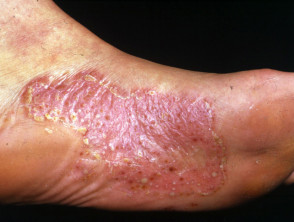What is palmoplantar pustulosis?
Palmoplantar pustulosis is an uncommon chronic pustular condition affecting the palms and soles. It is also called pustulosis palmaris et plantaris. It is related to a common skin condition, psoriasis.
A variant of palmoplantar pustulosis affecting the tips of the digits is called acrodermatitis continua of Hallopeau or acropustulosis.
What are the clinical features of palmoplantar pustulosis?
Palmoplantar pustulosis presents as crops of sterile pustules occurring on one or both hands and feet. They are associated with thickened, scaly, red skin that easily develops painful cracks (fissures).
Palmoplantar pustulosis varies in severity and may persist for many years. The discomfort can be considerable, interfering with work and leisure activities.
Certain manual occupations or occupations involving much walking are inadvisable for affected individuals.
Palmoplantar pustulosis
See more images of palmoplantar pustulosis.
Conditions associated with palmoplantar pustulosis
Certain conditions have been reported to occur in patients with palmopustular pustulosis more often than in unaffected patients, including:
- Chronic plaque psoriasis (10–25% of patients)
- Autoimmune diseases particularly gluten sensitive enteropathy (coeliac disease), thyroid disease, and type 1 diabetes
- Streptococcal tonsillitis
- Rarely, synovitis–acne–pustulosis–hyperostosis–osteomyelitis (SAPHO) syndrome.
Palmoplantar pustulosis may rarely be provoked by the tumour necrosis factor (TNF)-alpha inhibitors (infliximab, adalimumab, etanercept).
What is the cause of palmoplantar pustulosis?
The exact cause of palmoplantar pustulosis is unknown. There have been several theories.
- It may be a disorder of the eccrine sweat glands, which are most numerous on palms and soles.
- Genetic factors are important as several members of some families are affected. Some cases have been associated with IL36RN gene mutations
- It may be autoimmune and autoinflammatory in origin.
- Some cases are drug-induced and are especially reported in patients on tumour necrosis factor (TNF) alpha inhibitors.
The majority of patients with palmoplantar pustulosis are current smokers and in those that have smoked in the past (65–90%). It is thought that activated nicotine receptors in the sweat glands cause an inflammatory process.
How is palmoplantar pustulosis diagnosed?
Palmoplantar pustulosis is generally diagnosed clinically.
- Laboratory tests for bacterial infection are negative.
- A skin biopsy may be helpful but is rarely necessary.
What is the treatment of palmoplantar pustulosis?
Treatment of palmoplantar pustulosis does not cure the disorder and is not always successful. The following may be helpful.
General measures
- If you smoke, try to stop: however, palmoplantar pustulosis may take several months or longer to improve.
- If you have coeliac disease, follow a strict gluten-free diet.
- If you have recurrent tonsillitis, consult an otolaryngologist to see if a tonsillectomy is recommended.
- Choose comfortable footwear made from natural fibres.
- Avoid friction and minor injuries.
- Cover deep fissures with a waterproof dressing.
- Rest the affected area.
Emollients
- Use plenty of a thick emollient to soften the dry skin to prevent fissures.
- Soak in warm water with emulsifying ointment for 10 minutes.
- Apply soft white paraffin liberally
- Use salicylic acid ointment, urea cream or a heel balm to peel off dead skin (this may sting).
- Wash using bath oil or soap substitute.
Topical steroids
Topical steroids are anti-inflammatory agents which range in potency and vehicle. Only the strongest ointments are effective in conditions affecting the thick skin of the hands and feet. However, the very potent products such as clobetasol propionate should be used only for limited periods or else side effects and loss of efficacy become a problem.
A thin smear should be applied twice daily to the affected area. The effect may be enhanced by using plastic occlusion for a few hours or even overnight – use polythene gloves, plastic bags or cling film. Do not use occlusion for more than five days in a row.
Coal tar
Crude coal tar is very messy but applied directly to the pustules every five days or so can stop them occurring. Paint on carefully and cover. It can be mixed in an ointment base for easier application.
Acitretin
Acitretin tablets, derived from Vitamin A, can control palmoplantar pustulosis in the majority of users. They have some potentially serious side effects so are only suitable for significantly disabled patients. A newer retinoid, alitretinoin, may also be effective.
Phototherapy
Narrowband UVB and photochemotherapy (the combination of exposure to ultraviolet radiation [UV-A]) with psoralens taken as tablets or applied topically — bathwater PUVA —can be very effective. Careful supervision is necessary to avoid burning.
Other treatments
A variety of other medications can help some subjects including:
New biologics are under investigation for the treatment of palmoplantar pustulosis.


